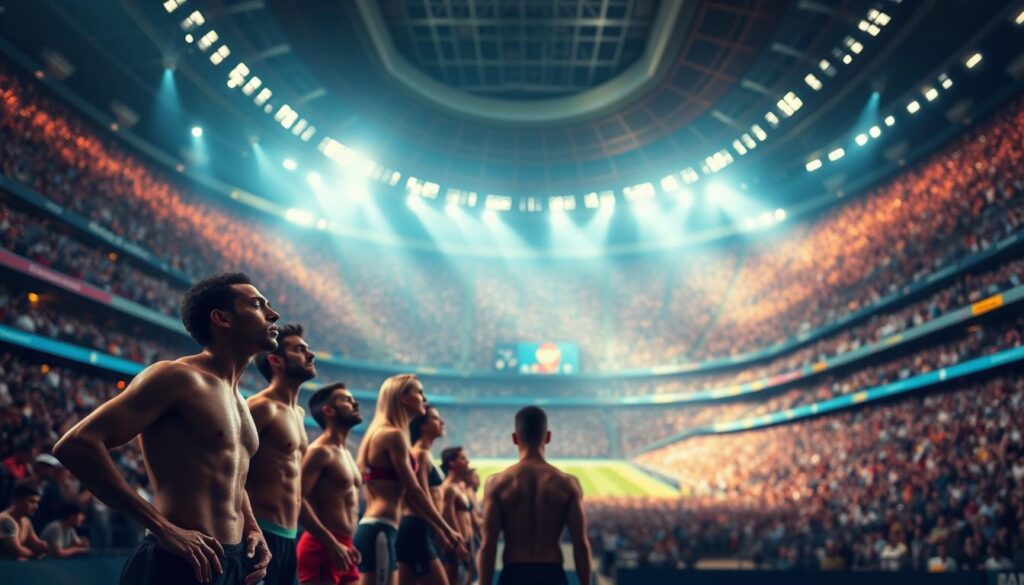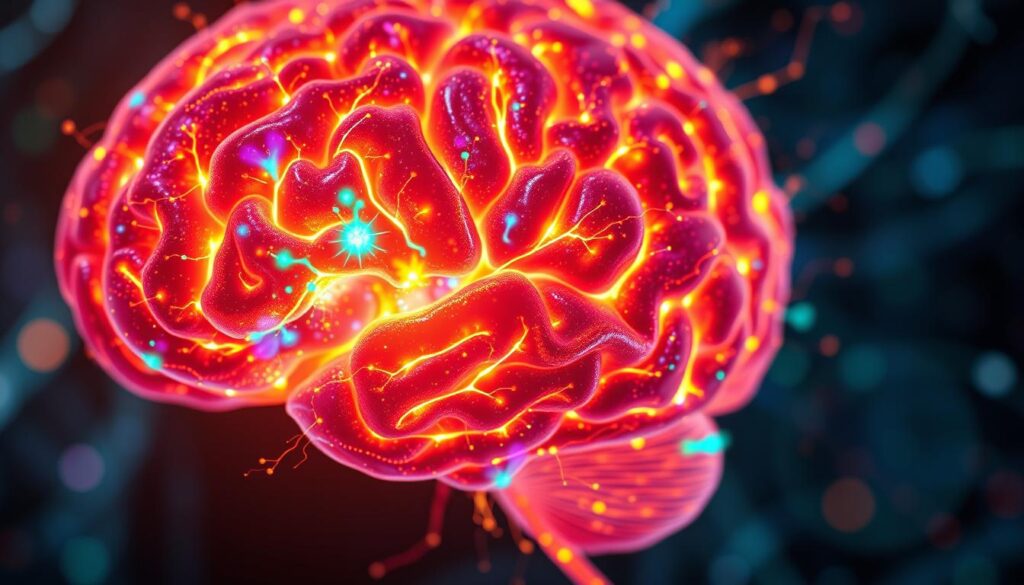Ever wondered what makes top athletes stand out? I realized it watching Lindsey Vonn ski. She moved with ease, as if she’d done it a thousand times. But what I didn’t know was that mental training is just as important as physical.
Visualization is a key tool for elite athletes. It’s not just about physical training. It’s a mental game that’s just as important. This tool can boost our performance too.
Studies show that over 90% of elite athletes use imagery in their training1. Visualization doesn’t just paint a picture; it makes the future real. Michael Phelps started visualizing at 11. He used it every night to relax and rehearse races2.
His coach, Bob Bowman, says Phelps is the best at visualization2. Olympians visualize different scenarios and rehearse their performances many times. This boosts their success.
Visualization can improve athletic results by up to 20%1. So, what can we learn from these success stories? How can we use visualization to improve our lives?
Key Takeaways
- Olympic athletes frequently use visualization techniques, with over 90% incorporating imagery in their routines1.
- Michael Phelps started using visualization at age 11, contributing significantly to his Olympic success2.
- Research shows that mental rehearsal can improve performance by up to 20%1.
- Visualization can lead to a 40% improvement in confidence levels before competitions1.
- The brain struggles to distinguish between real and imagined events, making visualization more effective2.
Understanding the Concept of Visualization
Visualization turns complex data into pictures, making it simpler for our brains to understand3. It’s about creating mental images of achieving a goal in a detailed way. This includes imagining sights, sounds, and feelings of success, boosting performance and results4
Knowing how to use visualization is key, which involves tools like charts and dashboards5. It helps find patterns and trends fast, important in many fields like healthcare and finance3.
For example, business dashboards show data clearly, helping make quick decisions and improving work flow4. Line charts can show a company’s profits over years, showing growth and big changes3. Good visualization means clear design, fitting for the audience, and clear actions from the data5. So, knowing what is visualization and how to use it is vital for turning data into useful insights.
How Olympic Athletes Use Visualization
Olympic athletes use visualization to boost their performance. They mentally prepare for competitions with specific techniques. Visualizing success is a key part of this.
Picturing Victory
Athletes like Mikaela Shiffrin imagine themselves winning before the race. This mental practice builds confidence and makes the real event less scary. For instance, Grant Holloway, a two-time 110m hurdles world champion, uses visualization to make his races feel automatic6.
They don’t just see themselves winning; they also hear the crowd and feel the excitement. Creating mental images of success can improve an athlete’s performance7.
Engaging All Senses
Olympic athletes use multisensory techniques to enhance their visualization. They engage their senses, including hearing, touch, and emotions, to make their mental rehearsals more real. Dr. Jennifer Cumming says this multi-sensory approach can greatly improve visualization6.
Those who regularly visualize are more likely to succeed than those who don’t. This shows how vital these techniques are for reaching the top7. The Olympic State of Mind experience combines visualization with mindfulness and motivation. Athletes like Thomas Rohler find it helpful for personal growth and business8.
Mental Preparation Before Competitions
Mental preparation is key for athletes, boosting performance beyond physical skills. Regular pre-competition routines improve focus and lower anxiety. This makes mental rehearsals vital for Olympic athletes. These strategies help athletes succeed in big events.
Pre-Event Mental Rehearsals
Olympic athletes prepare mentally before games, using visualization and other techniques. These rehearsals, lasting 5 to 10 minutes, boost confidence9. They can also improve skill accuracy by up to 25% in competitions10.
Visualization and deep breathing lower anxiety, getting athletes ready mentally10.
Examples from the Winter Olympics
Winter Olympians use specific mental preparation methods. For example, Canadian bobsledder Lyndon Rush mentally rehearsed the Sochi track. This helped him prepare for the race’s details. Studies show 75% of athletes feel more confident after these practices9.
Using mental imagery before games can also improve performance by up to 20%9.
During the Winter Olympics, many athletes show the value of mental rehearsals. Almost 54% of participants who practice spirituality use these techniques to improve their performance. This is compared to only 13% who don’t engage in spiritual practices11. These disciplined mental preparation methods are often essential for peak performance.
Understanding and using these mental preparation techniques, like visualization and mindfulness, shows why they’re vital for Olympic athletes. They compete at the highest levels of sport.
The Science Behind Visualization Techniques
Visualization is more than just a psychological trick. It’s a scientifically backed method that changes the brain like real actions do. It’s interesting to see how it works and why it’s so effective. This part will look at studies that prove its worth and explore the brain science behind it.
Studies Supporting Visualization
Studies show that visualization boosts performance and helps with mental health. Research finds that imagining an activity can activate the brain like doing it for real (Meister et al., 2004)12. It also shows that using all senses in imagery engages more brain areas, like the parietal lobe and hippocampus, which are key for thinking and memory12.
May et al., 2008, found that vivid mental pictures help control behavior12. This is backed by more research showing that visualization uses the same brain paths as real experiences. It affects mood, motivation, and memory by releasing dopamine13. Olympic athletes use it to stay at top performance, showing its power for achieving big goals, even with emotional challenges12.
Neuroscience of Visualization
The brain science of visualization shows it’s a strong tool for better performance. Studies show that the brain acts the same during visualization as it does during real activities. This makes it a great mental training method.
Visualization can also help manage stress and anxiety, leading to better mental health13. It can change how we see problems, making us more positive (Oettingen & Reininger, 2016)12.
Visualization also boosts attention, focus, and memory. This is great for work, where it can make people more productive and less absent due to stress13. Mindful meditation with visualization also helps reduce stress and reach goals, making it a complete mental wellness strategy13.
Visualization Exercises for Personal Development
Visualization exercises are a powerful tool for personal growth. They help people improve themselves through mental images. Daily practice, like Olympians and CEOs do, boosts cognitive skills14. To see results, you need to be consistent and dedicated15.
Visualization exercises can make learning better, as shown in nursing student studies15. They use more than just sight, including sound, touch, emotions, and smell. Here are some exercises to boost confidence, set goals, and achieve results.
Candle Exercise: Light a candle and focus on the flame. See its flicker, colors, and warmth in detail. This improves focus and sensory experience15.
Apple Visualization: Imagine holding an apple. See its texture, color, smell, and taste. This exercise boosts memory and brain skills15.
Globe Exercise: Close your eyes and picture a globe. Build a detailed mental image of continents, oceans, and countries. This enhances memory and spatial skills15.
Clock Exercise: Imagine an analog clock. See the hands move and hear the ticking. This improves spatial and auditory skills15.
| Exercise | Focus Area | Benefits |
|---|---|---|
| Candle Exercise | Visual, Emotional | Enhances Concentration, Sensory Engagement |
| Apple Visualization | Multi-sensory | Improves Memory, Cognitive Skills |
| Globe Exercise | Visual, Spatial | Enhances Memory Retention, Spatial Intelligence |
| Clock Exercise | Auditory, Spatial | Bosters Spatial and Auditory Visualization |
Practice visualization daily to keep your mind sharp. Experts say to do it twice a day, in the morning and before bed14. Regular practice helps you reach your goals and improves yourself through visualization14.
Creative Visualization vs. Guided Visualization
Understanding the difference between creative and guided visualization is key. Each type has its own way to improve mental and physical skills. Creative visualization lets you imagine freely, while guided visualization follows a script.
Defining Creative Visualization
Creative visualization lets you dream up your goals without rules. It’s all about making your dreams come true. Jim Carrey, for example, imagined earning $10 million for “Dumb and Dumber” in 1994, after writing a check in 198716.
Adding physical activity to visualization boosts learning. Just one hour a day can make a big difference17. It also boosts your creativity and self-confidence, says the American Psychological Association17.
Understanding Guided Visualization
Guided visualization uses a script to guide you through images and scenarios. It’s common in therapy and can help you feel calm and relaxed16. Even just 10 minutes can lower anxiety and improve health1617.
These sessions usually last 20 to 30 minutes. They can be done alone or with others16. Adding calming music or silence can make them even more effective18.
Both creative and guided visualization have their own benefits. Using them together can make your practice even more powerful161718.
Visualization Tools Used by Olympians
Olympic athletes use many tools for effective visualization in their training. These tools, like goal boards and imagery scripts, help sharpen their mental focus. They also boost their competitive edge.
Goal Boards
Goal boards in sports show an athlete’s goals and past wins. They remind athletes daily of their goals and motivate them. About 75% of Olympic athletes use visualization techniques in their mental prep19.
Visualization can improve performance by up to 20% in training. So, goal boards are key for athletes to stay focused and clear19.
Imagery Scripts
Imagery scripts for performance are detailed visualizations of routines. They engage all senses for a vivid mental practice. Athletes who use visualization see a 25% boost in self-efficacy compared to non-users19.
Visualization can also improve skill by 15%19. It works the brain like physical practice does. This shows the brain benefits of visualization20.
Real-Life Stories: Lindsey Vonn and Mikaela Shiffrin
In the world of competitive skiing, Lindsey Vonn and Mikaela Shiffrin stand out. They show how visualization can lead to success. These Olympic skiers have made mental imagery a key part of their training.
Lindsey Vonn’s Visualization Practice
Lindsey Vonn is the winningest female skier, with 82 World Cup victories. She credits visualization for her success. She mentally goes through each race, imagining every detail.
This practice helped her win three Olympic medals and bounce back from injuries, like a knee injury in 201521. Research shows mental imagery can boost performance by 20-30%21.
Mikaela Shiffrin’s Pre-Race Rituals
Mikaela Shiffrin has won 88 World Cup races, breaking Vonn’s record21. She spends 30 minutes daily on visualization. This helps her stay calm and focused during races21.
At 18, Shiffrin became the youngest gold medalist in women’s slalom. She brought the US its first Olympic gold in slalom in 197222. Her pre-race rituals help her prepare mentally and emotionally.
Both Vonn and Shiffrin show the power of visualization in sports. Their stories prove how mental preparation can turn talent into greatness. They inspire others in the world of Olympic skiing.
FAQ
What is visualization, and how is it relevant to achieving goals?
How do Olympic athletes like Mikaela Shiffrin and Lindsey Vonn use visualization?
What are the essential components of effective visualization?
Can you provide examples of specific visualization techniques used by Olympic athletes?
What mental strategies do athletes use just before high-stakes competitions?
Are there studies that support the effectiveness of visualization techniques?
How can I incorporate visualization exercises into my daily routine for personal development?
What is the difference between creative visualization and guided visualization?
What specific tools do Olympians use to facilitate effective visualization?
Can you share personal visualization strategies used by Lindsey Vonn and Mikaela Shiffrin?
Source Links
- The Power of Visualization – IDEA Health & Fitness Association – https://www.ideafit.com/the-power-of-visualization/
- How Michael Phelps Used Visualization to Stay Calm Under Pressure – https://www.yourswimlog.com/michael-phelps-visualization/
- What is Data Visualization and Why is It Important? – GeeksforGeeks – https://www.geeksforgeeks.org/data-visualization-and-its-importance/
- What is Data Visualization and Why is it Important? | Definition from TechTarget – https://www.techtarget.com/searchbusinessanalytics/definition/data-visualization
- An introduction to data visualization – https://digital.gov/resources/an-introduction-to-data-visualization/
- The secret to track & field success: Visualisation and manifestation – https://www.olympics.com/en/news/secret-to-track-field-success-visualisation-manifestation
- Think like an Olympian – https://www.vox.com/even-better/362840/olympians-olympics-mental-hacks-visualization-sports-psychology-mindset-elite-athletes
- Olympic State of Mind: Mindfulness, visualisation and motivation – https://www.olympics.com/en/news/olympic-state-of-mind-mindfulness-visualisation-motivation
- How To Prepare Mentally Before Competition – https://www.successstartswithin.com/sports-psychology-articles/mental-preparation-for-sports/how-to-prepare-mentally-before-competition/
- The Art of Mental Preparation: The 10 -Step Guide for Effective Pre-Competition Routines – https://medium.com/@colin.jonov10/the-art-of-mental-preparation-the-10-step-guide-for-effective-pre-competition-routines-31af590e2bf0
- Use of mental techniques for competition and recovery in professional athletes – https://pmc.ncbi.nlm.nih.gov/articles/PMC4875065/
- The Science Behind Imagery and Visualisation – https://www.psychologytoday.com/intl/blog/imagery-coaching/202402/the-science-behind-imagery-and-visualisation
- The Science of Visualization: How to Encourage Positive Thinking and Goal Achievement – https://www.corporatewellnessmagazine.com/article/the-science-of-visualization-how-to-encourage-positive-thinking-and-goal-achievement
- 5 Visualization Techniques to Help You Reach Your Goals – https://www.betterup.com/blog/visualization
- 5 Powerful Visualization Exercises and Techniques [Step-by-Step Walk-Through] – https://www.magneticmemorymethod.com/visualization-exercises/
- Visualization and Guided Imagery | Benefits & Uses | Koshas – https://koshas.com/practice/visualization-and-guided-imagery/
- How to Use Positive Visualization in Your Everyday Life – https://psychcentral.com/lib/imagery-in-everyday-life
- Guided Imagery and Visualization Meditation – Headspace – https://www.headspace.com/meditation/guided-imagery
- The Power of Visualization: Enhancing Performance in Sport and Exercise – https://www.drdevroy.com/visualization-in-sport-and-exercise/
- Here’s The Trick Olympic Athletes Use To Achieve Their Goals – https://www.businessinsider.com/olympic-athletes-and-power-of-visualization-2015-1
- Applied Machine Learning for Health and Fitness: A Practical Guide to Machine Learning with Deep Vision, Sensors and IoT [1st ed.] 9781484257715, 9781484257722 – DOKUMEN.PUB – https://dokumen.pub/applied-machine-learning-for-health-and-fitness-a-practical-guide-to-machine-learning-with-deep-vision-sensors-and-iot-1st-ed-9781484257715-9781484257722.html
- The Power of Vision — What Entrepreneurs Can Learn From Olympic Athletes – https://www.forbes.com/sites/vanessaloder/2014/07/23/the-power-of-vision-what-entrepreneurs-can-learn-from-olympic-athletes/






